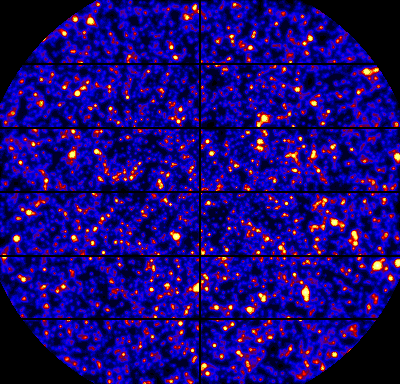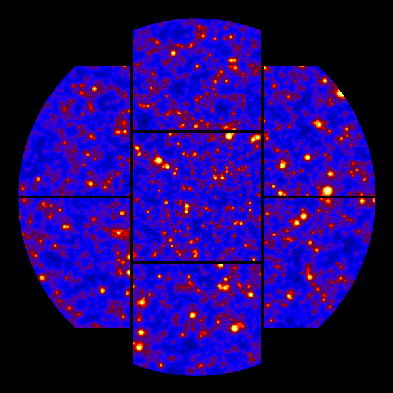Courtesy of the VILSPA XMM-Newton SOC
The Science Problem
QSOs and AGNs make up more than 35% of the diffuse X-ray background (XRB) at 1 keV with redshifts up to and beyond z = 1. Extrapolation of the currently available luminosity function to fainter fluxes cannot make up much more than 50% of the background, which is in accord with the isotropy of the XRB.QSO spectra in the ROSAT band are steeper than the background at harder energies, and furthermore at fluxes below 1E-14 ergs/(s cm²) the quasar source counts flatten off and are replaced by more numerous populations of relatively low red-shift objects, apparently Narrow Emission Line Galaxies (NELG). Spectra of nearby normal galaxies do not have the correct temperature to match the XRB, so the identification of the population of sources responsible for the above-mentioned deficit remains enigmatic, but these NELG populations are a popular choice, because they could simultaneously complete the source counts to resolve the requirement for the ROSAT band background, and provide a harder spectrum source to explain the mismatch between soft and hard diffuse spectrum components.
The possible candidate set of sources with appropriate spectrum to explain and mimic the diffuse spectrum at E > 1 keV include starburst galaxies, dominated by massive binaries and hot winds. At higher z, the evolution of starbursting epochs may also allow for a greater volume emissivity compared with current epoch observations. Faint blue galaxies are weakly clustered, consistent with weak angular correlation in the XRB, and these may be going through a starburst phase which disrupts the galaxies so that we no longer see these objects in large numbers today. The NELG might also include absorbed AGN which also potentially have the ability to mimic the required spectrum, while the luminosity evolution required for XRB sources is similar to that measured for other AGN populations.
Comparing XMM-Newton with other missions
ASCA is limited for these population studies by the relatively poor spatial resolution and confusion limits, but the deep fields are consistent with obscured Seyfert 2 galaxies although direct identifications have not been possible.For detecting and locating sources for follow-up, Chandra would be the premier observatory, but requires an enormous amount of observation time to achieve its flux limits of 1E-16 ergs/(s cm²) (due to the high angular resolution it will however be almost free of background). On the other hand, XMM-Newton with a larger high energy grasp will be important for determining the spectral parameters of the putative harder spectra of the resolvable galaxies. Furthermore the apparently well-understood 0.5 - 2 keV source populations may not easily extrapolate to the 2 - 10 keV band. With the improving angular resolution of XMM-Newton mirrors, confusion will be reached at deeper limits than previously expected, and will also allow for the determination of more accurate locations.
Resolving the background with XMM-Newton

This image shows the response of the EPIC pn camera. Note that we assumed no spacecraft drift, so that the blank pixels between individual CCDs have not been smoothed out.
We are carrying out detailed simulations with the XMM-Newton SciSim, in order to investigate dependencies of source luminosity functions, evolutionary and spectral properties. Ad interim we present here images of some first simulations which represent the expected picture derived from a 200 ks exposure of a blank field. We extracted the luminosity function from ROSAT Deep Survey results, and extrapolated by a factor of 2 - 3 to account for changes expected in the harder XMM-Newton band. The simulated PSF of the telescope and expected background in orbit were applied. We assumed that potentially all the sources down the 1E-17 ergs/(s cm²) make up the diffuse background, and accounted only for typical soft Galactic background. The images show the expected response of the EPIC pn camera, and two MOS cameras combined.

This image shows the response of two MOS CCDs combined. In reality the two cameras will be orthogonally aligned so the seam losses in between their chips (in black) will not be as apparent.
A next step is to introduce the detailed source simulations, and then to apply proper source detection algorithms. However, based on current estimates, it seems that XMM-Newton will be confusion limited at source fluxes a little below 1E-15 ergs/(s cm²).
[last update: 28 Jan 1998 by D. Lumb]
Return to Science with XMM-Newton page



